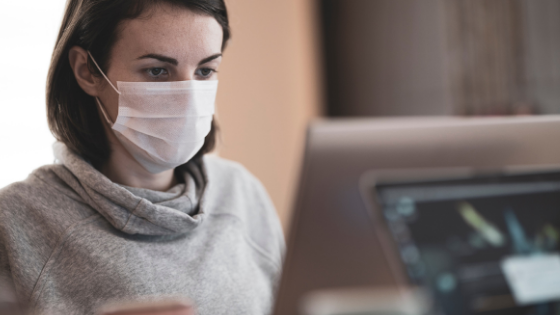Acne is something many of our customers struggle with and I understand the toll it can take on confidence and lifestyle – especially cystic and nodular acne.
Whether you’ve struggled with inflammatory acne for years, are dealing with pesky pimples, or are suddenly breaking out with Maskne I trust you’ll find this article helpful!
Maskne: How To Treat and Prevent It
COVID has certainly added a whole new list of words and phrases to our daily vocabulary, hasn’t it? Covid kilo’s, lockdown, pandemic, quarantine, social distancing, and one that has is now a hot topic in skin health: Maskne (Mask Acne)
Maskne: What it is and how to treat it
Face masks create the ‘perfect storm’ of friction, humidity, and moisture to clogged pores.
Acne bacteria thrive in clogged pores (it’s the ideal breeding ground) which leads to breakouts – even if you’re not usually prone to them.
Tackling maskne is all about adjusting your skincare routine and hygiene habits to help support your skin. Wearing a mask might be an inconvenience but it’s incredibly important for our community’s health, so keep masking!
7 Tips To Treat and Prevent Maskne
Wear Cotton mask
I love the creative and imaginative mask designs that popped up in the wake of COVID! It’s given us so many more options than the disposable mask – which doesn’t do the skin any favours long term.
Wearing a cotton mask is preferred as disposable masks are not made to be worn for long periods of time. If a disposable mask is all you have access to that is great but replace them frequently every 3-4 hours and do not continually take off and reuse.
Make your own mask!
VicGov has a handy downloadable guide and pattern on how to make your own mask – check it out here. This means you can choose your own fabric. I recommend for the inner layer to choose a breathable cotton fabric that is made to fit snugly around your nose and face will reduce friction & clogged pores.
Have a stash of masks
Keep a few masks on rotation so you have dry, clean options while dirty ones are in the wash. If you dry in the sun it will help to kill other bugs in the fabric as well.
Reacting to a cotton mask?
Check the detergent you’re washing it with – many cause irritation. Use a gentle soap like a castile soap or a washing powder/liquid free of fillers, parabens, and fragrances.
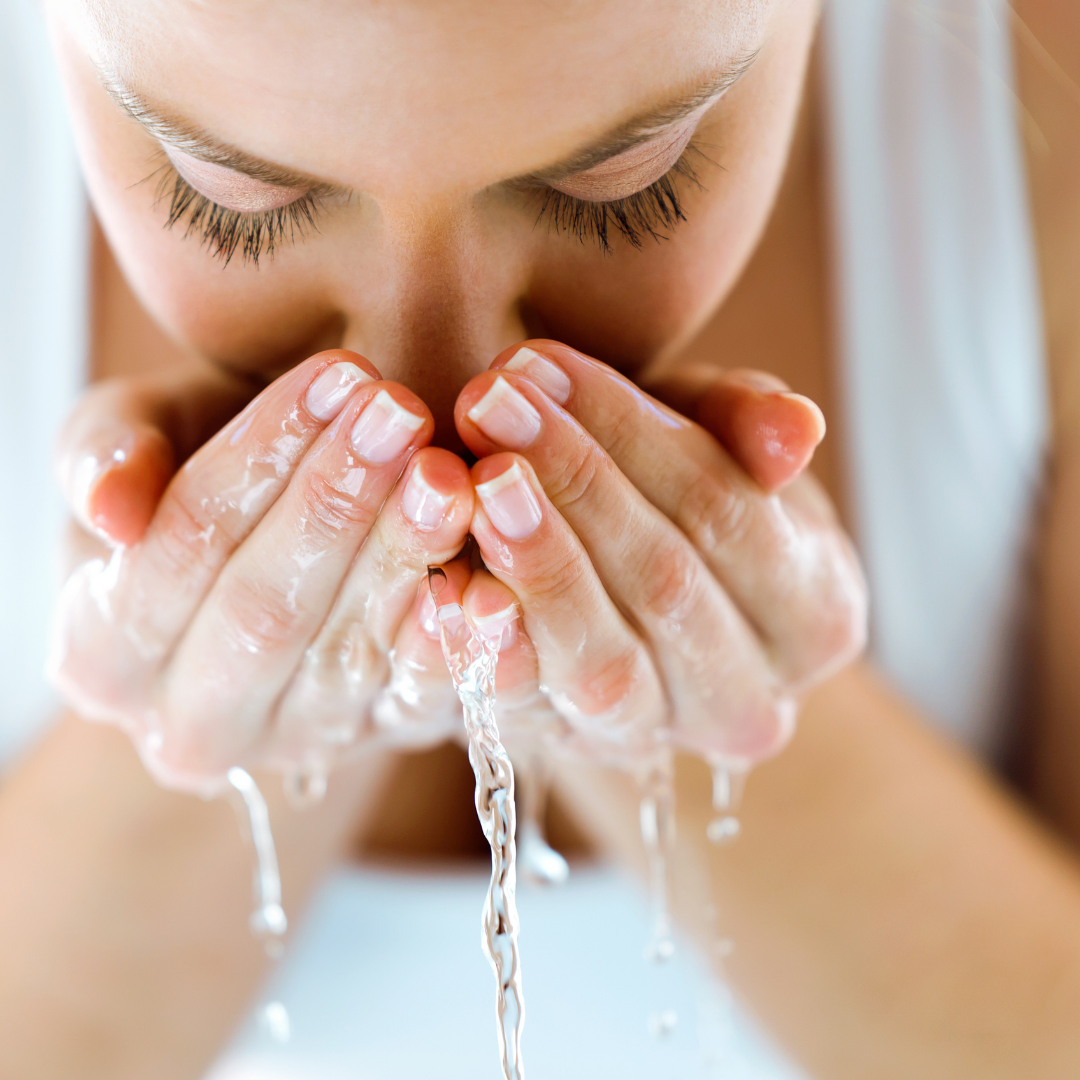
Cleanse twice a day
Cleansing in the morning and evening is crucial to keep maskne at bay.
Choose a natural cleanser that will help to hydrate your skin and unblock your pores. Gentle face washing (I call face splashing) with limited touching of the face is a good way to cleanse your pores and not disrupt the skin oil balance.
We love our Olive Oil Facial Bar or Acne bar and both are suitable for all skin types.
Wear less makeup
Wearing no or the less makeup around the mask area causes less friction and will allow your skin to breathe and reduce outbreaks
Keep skin hydrated
You hear this from me all the time, I know, but it is so important to keep your hydration levels up for healthy skin! Drinking water, of course, but also moisturising after cleansing is essential to keep your skin balanced too.
I recommend Replenishing Face Cream for dry to normal skin Manuka or Lavender Lotion for oily or younger skin.
Using a serum under your moisturiser can also boost hydration levels – especially around the nose and mouth area. I will give your skin an extra layer of protection and a hit of much needed antioxidants in the evening.
I recommend our Rejuvenating Facial Serum for dry-normal skin
Look after your lips
Lip care shouldn’t be forgotten when using a mask. Although they aren’t exposed to the elements, wearing a mask will definitely dry them out. Look after them by choosing a natural lipstick or lip balm that contains wax (preferably free from petroleum jelly), herbs, and oils to protect and hydrate.
I recommend Manuka Honey Lip Balm. Our customers absolutely love this balm and I think your lips will too!
Hormonal Acne: Causes and Diet Tips 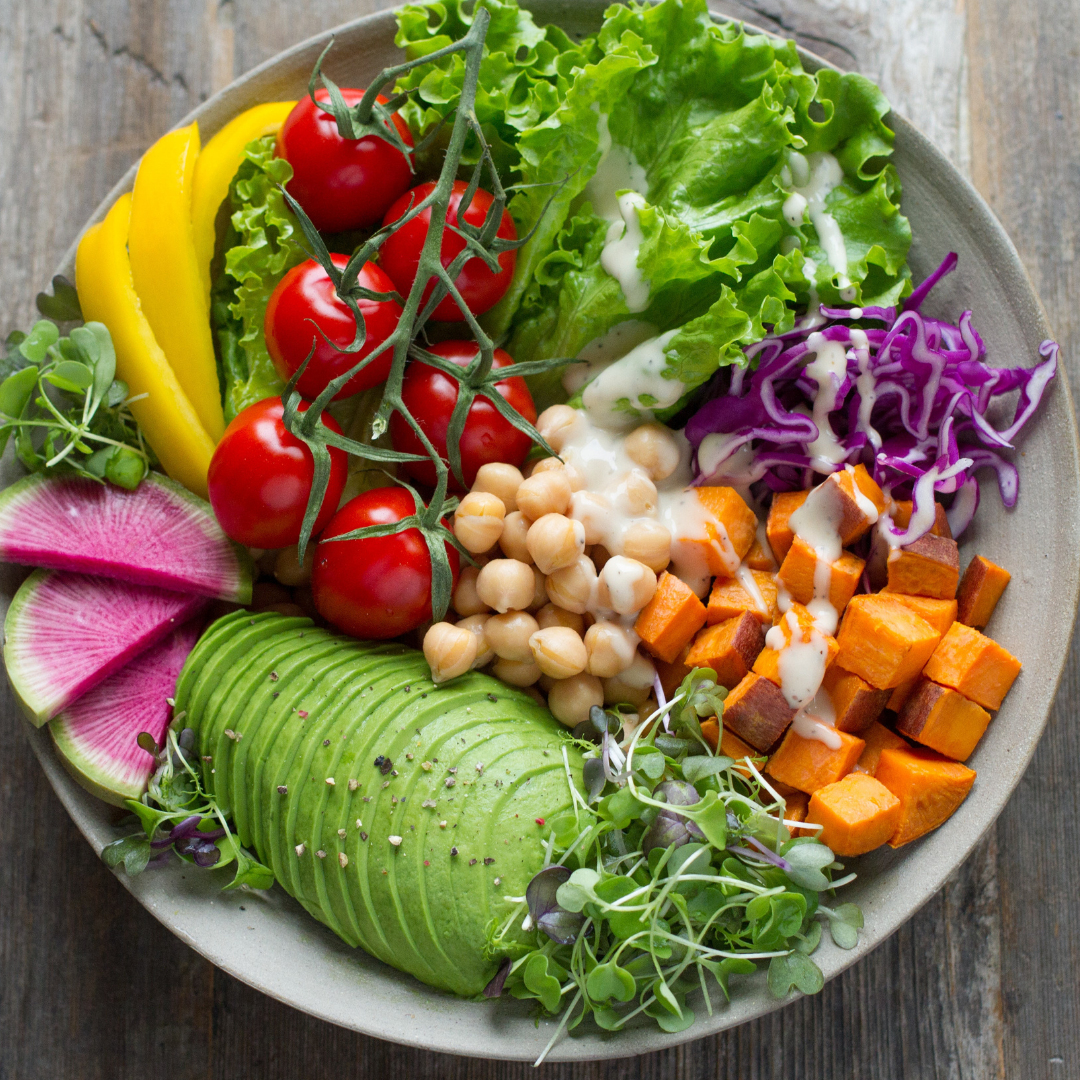
All acne, be it maskne, pimples, cysts, or nodules, all begin with the same issue – clogged pores.
The main cause of blocked pores is the overproduction of sebum – the skin’s natural oil
When too much oil is present on the skin surface it mixes with dead cells and other debris (like makeup / dirt) and plugs up the pore. This clogged pore is the ideal environment for skin bacteria, p. Acnes, to thrive.
Haywire hormones are a major culprit of excess oil production in the skin. When hormone levels surge or drop and become imbalanced your skin is triggered to create more oil.
This explains why you don’t ‘leave acne behind’ once puberty is over.
Hormonal changes happen into adulthood too – menopause, pregnancy and the menstrual cycle have a lot to answer for when it comes to experiencing acne as an adult.
Teenage acne
Teenagers experience many crazy hormonal changes. At times hormones surge and other times, they drop as they try to find a balance in the body.
Adult acne
Once again, wild hormone fluctuations can occur during pregnancy or menopause when we see our hormone levels again reduce or rebalance.
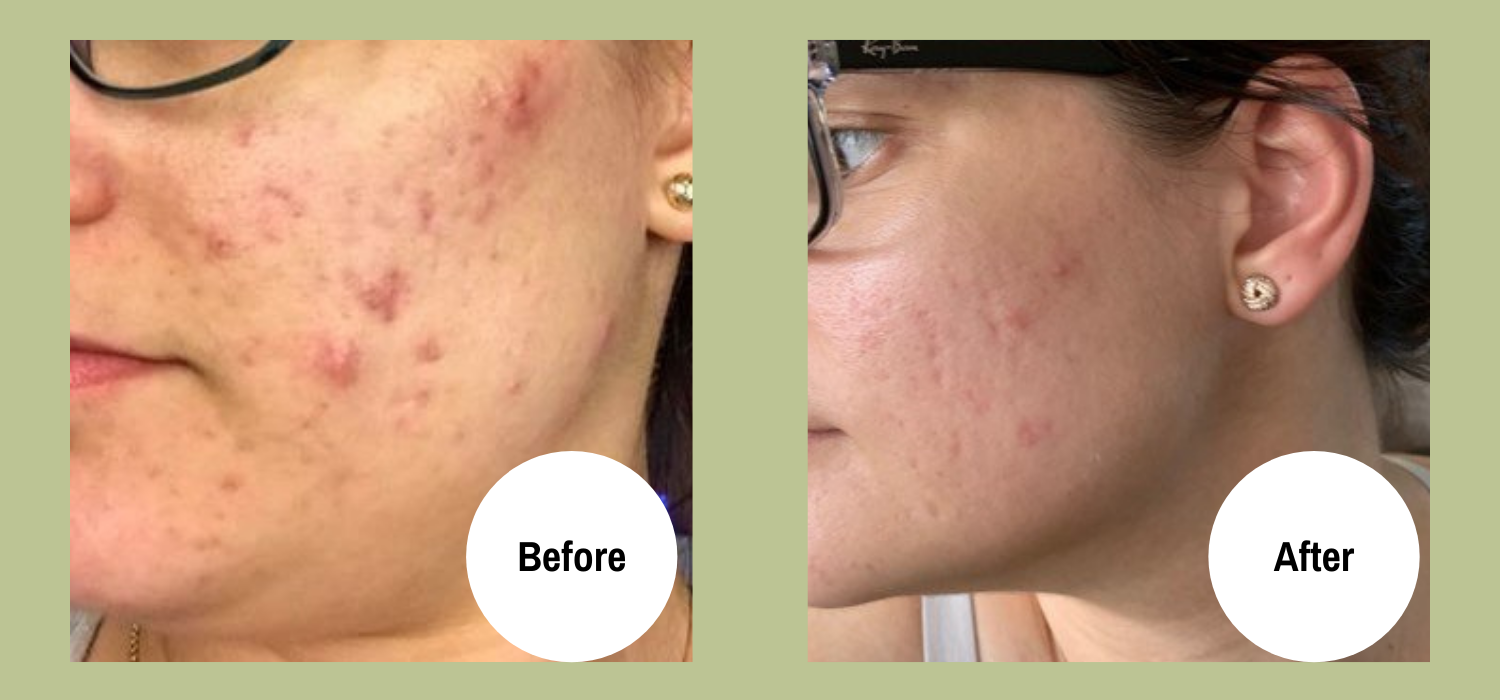
Olive & Ash customer progress using our humble olive oil products.
A note on PCOS
Polycystic ovary syndrome (PCOS) is a hormonal disorder and reproductive issue with acne being a common symptom. If you present with PCOS there are many naturopathic options available to help manage this syndrome. Avoiding excess sugar, maintaining a low GI diet and healthy body weight are excellent starting points.
Diet Tips To Help Treat And Prevent Hormonal Acne
Eat a rainbow of foods for optimal gut and skin health
While treating hormonal acne takes a holistic approach, simple changes to your diet can play a big role in clearing active breakouts and minimise the chance of recurrence.
The health of the skin and gut are intrinsically connected. Supporting your gut health with the right vitamins and minerals is essential for tackling hormonal acne symptoms.
While the best way to get nutrients into your body is with a diet of whole, organic fresh foods, nutritional supplements can play a role too. If you’re a vegan or vegetarian, you’ll likely need supplements for the nutrients not available in your diet.
They should act as they’re intended though – a supplement – not a replacement for real, nutritious food.
Key vitamins, minerals, and foods to deal with hormonal acne (and what to avoid!)
Zinc
Zinc is essential for healthy skin and acne management thanks to the way it works with Vitamin A. Vitamin A is an essential nutrient for balanced skin and the treatment of acne (acne medication Accutane is a derivative of vitamin A) and Zinc is required to activate Vitamin A in your liver.
Oysters, lentils, chickpeas, sunflower seeds, nuts, and miso soup are all good sources of zinc.
Vitamin B12
An essential nutrient and only available in drops or dissolvable tables. Visit your health food shop, good chemist or your GP can give you an injectable B12 if you have very low levels.
Vitamin D
Some sun exposure is essential for health and wellbeing. It’s important to have a bit of time in the sun either early in the morning or/and late in the afternoon without sunblock.
Vitamin E
Fill up on nuts (like almonds, and peanuts), seeds (sunflower seeds are a great choice) and leafy green veggies. You can’t get enough leafy greens in your diet!
Omega 3 essential fatty acids
Choose fresh fish – preferably fatty fish including mackerel, salmon, and sardines.
The bottom line? Eat a wide variety of fresh fruit and vegetables! Just think of a rainbow and eat as many colours of fruit and vegetables as you can.
Probiotics
Support good gut health and healthy skin by including prebiotic foods in your diet – chicory root, dandelion greens, garlic, onions, and leeks are good sources – and a quality probiotic capsule. This is especially important if you are taking antibiotics for your acne.
Drink plenty of water and hydrating teas
Excess oil production can be triggered by dehydration. Oily skin does not mean your face is hydrated – it’s often a sign of dehydration.
Foods to avoid
We all react to foods differently and there’s no hard and fast rule to say that eliminating one type of food is guaranteed to clear acne for every person.
That said, there are absolutely foods to avoid if you want to improve skin health and aid in clearing acne. As a general rule, avoid foods that trigger an inflammatory reaction in the skin.
Refined sugar
Refined sugar has been shown to fuel the overproduction of sebum in your skin. These foods spike your insulin levels quickly which triggers the skin to produce sebum. Sugar is also highly inflammatory.
Highly processed carbohydrates
Like refined sugar, filling up on processed, high GI foods like pizza, white bread, bagels, some breakfast cereals, all trigger an inflammatory and oil producing response.
Dairy products
There is also evidence to support that dairy products, especially low fat dairy milk, can irritate or trigger acne in some people. Research has shown women who drink a glass of lot fat dairy each day are 22%-44% more likely to experience acne.
Chocolate can also exacerbate acne as it is high in dairy, sugar, and cocoa which is often high in histamine.
Experiment by making changes to your diet to cut out or reduce dairy, refined sugars, and highly processed foods and monitor skin improvements.
Acne And Histamine Sensitivity
Histamine intolerance can play a major role in skin concerns. Research on the connection between gut health, histamine sensitivity and skin tells us that hives, acne and eczema are often symptoms of histamine sensitivity.
You can help keep histamine responses in check by avoiding foods that contain high levels of histamine including fermented foods (yoghurt, kaffir, kampuchea, kimchi, sauerkraut) banana’s, tomatoes, chocolate, processed foods, and shellfish.
Dietary changes take time to show
Be patient! The skin takes 4-6 weeks to regenerate so changes in your diet need to be maintained for at least 6 weeks for the benefits to show.
Acne Face Mapping: What Breakouts Can Tell You 
Cheeks, forehead, chin, back. Did you know that where acne appears can tell you so much about what’s going on inside your body?
“Face mapping” has been used in Chinese health assessment for over 3,000 years.
Essentially, it’s the practice of observing skin concerns presenting in your complexion – be it acne, dullness, colour – and connecting different concerns with underlying organ / health issues.
Using the technique of face mapping may be able to help you interpret what your skin is trying to tell you about your body. Below is a general guide on what your acne may be telling you by where it’s appearing:
Chin: The chin area is known to represent hormonal imbalance.
Cheeks: The area of acne around the cheek can be broadly associated with the lungs and respiratory issues. Or it might just be telling you to spend less time on your phone! The dirt and bacteria on your phone screen can contribute to breakouts when pushed up against your cheek.
Forehead: Acne over the forehead (be it a few pimples or serious breakout) can represent an issue with the small intestine. Small intestinal bacterial overgrowth (SIBO) is an issue that affects the upper small intestine.
Under Eye: Acne around the underside of the eye is represented by the kidney. Underlying kidney issues may also present as a waxy look under the eye.
Cystic or nodular acne: Acne that presents in the form of cystic or nodular acne (inflammatory acne) can stem from deeper gut issues.
Like everything in life we are all made differently and the information above is not 100% for every single person. However, as a Naturopath, face mapping is something I consider when looking deeper at how to treat or prevent acne.
8 Skincare and Lifestyle Tips To Help Treat Acne
Dealing with a pesky little breakout or a more serious form of acne? Either way, how you manage our skincare (not just products!) can contribute to improving overall skin health.
Lifestyle tips to stop the spread of bugs/pathogens (bad bacteria)
Change your pillowcase regularly
Replacing your pillowcase a few times a week will stop the spread of bugs and excessive oil residue. Opt for breathable fabrics like cotton or silk.
Clean your mobile phone
Get into the habit of wiping down your mobile with a microfibre cloth.
Quit touching your face
Nothing spreads bacteria quicker than constantly touching or picking at the skin. Keep your hands off!
Skincare Tips To Clear, Calm And Balance Acne-Prone Skin
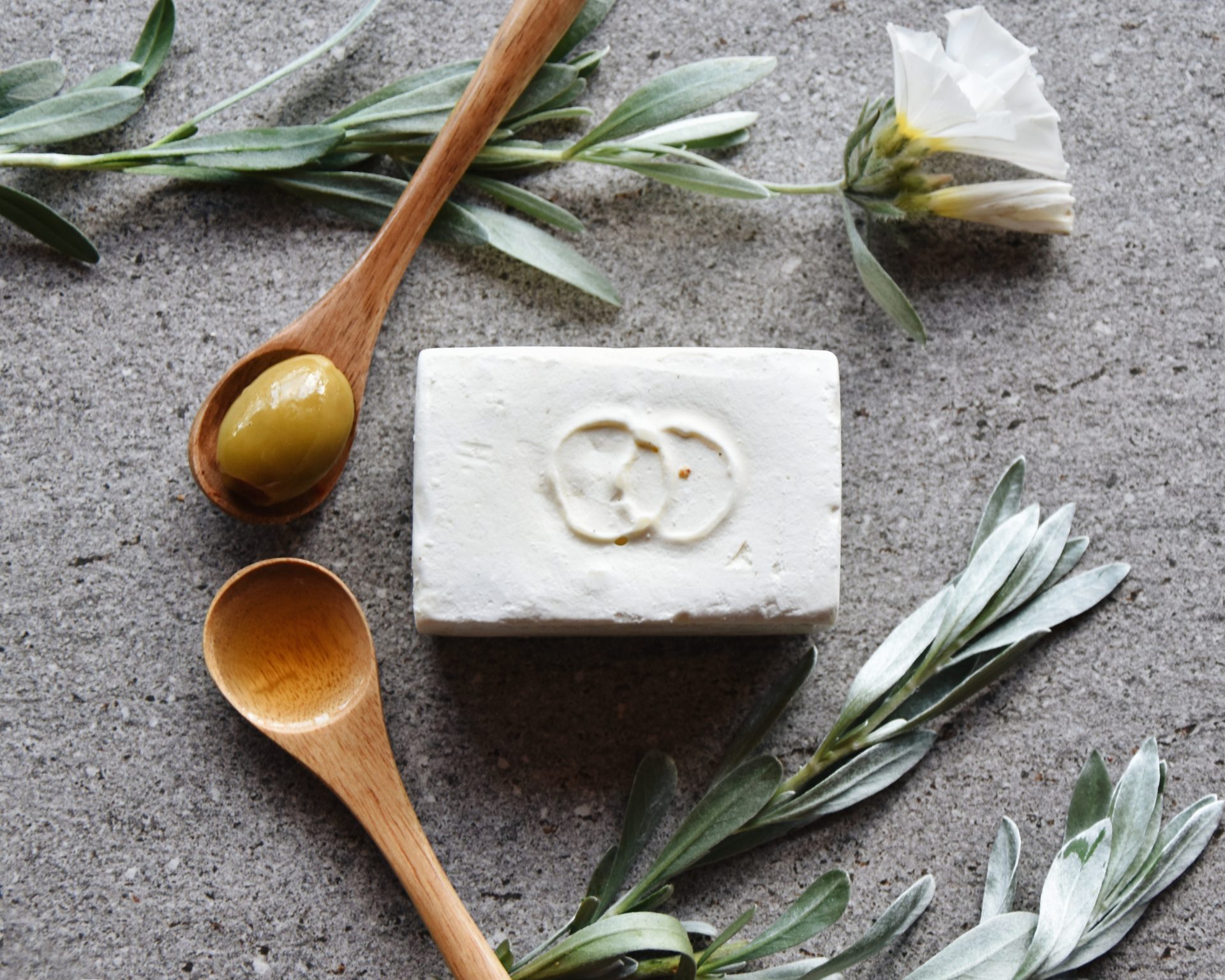
Use a gentle cleanser
Avoid harsh cleansers that strips your skin of its natural oils leaving it feeling ‘tight’. Foaming cleansers with chemicals like SLS will do this.
Removing every trace of oil actually triggers skin to create more. Acne prone skin will benefit from a gentle cleanser that helps skin retain its oil/moisture balance.
Choose light moisturisers
Don’t suffocate acne skin with heavy moisturisers – use a light, fast absorbing moisturiser. “Oil-fee” isn’t always best as acne prone skin can benefit from certain kinds of oils.
Mineral makeup is your friend
Mineral powder, foundation, and BB creams provide coverage without clogging pores. It also contains beneficial minerals for skin like zinc.
Treat inflamed skin with a clay mask
Choose kaolin clay as it’s gentler on skin and look for calming formulations that contain soothing herbs like chamomile, lavender, rosemary or tea tree. Always follow a clay mask with a moisturiser to prevent skin drying out.
